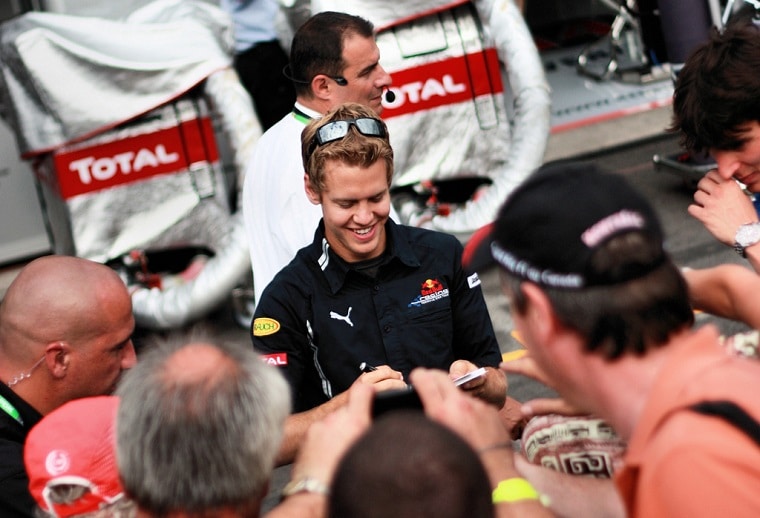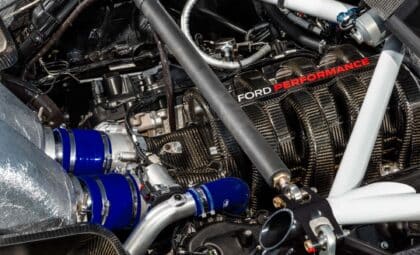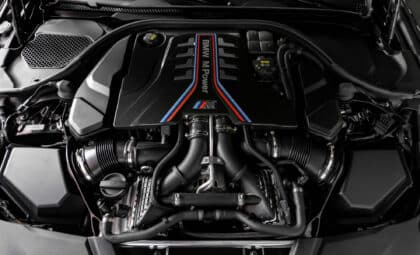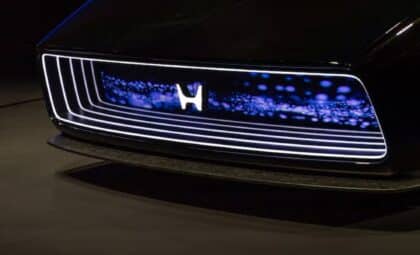Sebastian Vettel (2009), now a four-time world champion, was brought up through the Red Bull Junior Team
Photo: nick@
Becoming a Formula One driver, even if you have successfully climbed the junior formula ladder, isn’t simple. Drivers need to attract a team’s attention and somehow convince them they are the next hottest thing. They need, ideally, as much testing as possible in an F1 car to guarantee they don’t become one of the many drivers in history with promising junior careers who moved on to F1 only to do very poorly, as the skills sometimes do not translate. Doing either of these things without a truly glowing junior career or some form of financial backing can be difficult.
Drivers also need to be prepared for unceasing media attention, to say the right things to the cameras but also to be interesting and friendly. They are in many ways the public face of the team and thus need to have the right attitude not just for the media but also for the hundreds of people who work on the engineering and technical side and who look to them to deliver the results, represent them, and not undermine them when things go wrong. And they need to do all this, or be ready for it, at a fairly early age—because if they don’t, someone else will.
Need to Know: Seasonal maintenance tips for your car
It should thus come as no surprise that many drivers are chaperoned into Formula One via young driver programs designed to help them out along the way. All the big teams in the sport have such programs, which seek out promising drivers in junior formulas, get them signed before other teams can, and then guide them through the motorsport ladder with funding and support.
Though young drivers in these programs are often bound to the teams through long-term, low-paying contracts, they receive the patronage of an established team and a clearer entry into F1 after they have done all they can in feeder series. Surprisingly, even with a successful junior career, finding that entry point can be difficult: many drivers have stormed through junior formulas only to be unable to secure an F1 seat for various reasons. Being part of a young driver program can help raise their chances and has worked well in the past for several teams.
Leasing a Car: What are the benefits?
Red Bull Junior Team
The Red Bull Junior Team is the most famous and successful driver development program in Formula One. It was created in 2001 and is run by Helmut Marko, who is also an advisor to Red Bull Racing. The program has successfully brought six drivers into its F1 team, including Sebastian Vettel, who won all four championships from 2010 to 2013 and now drives for Ferrari, and the two current Red Bull drivers—Daniel Ricciardo and Max Verstappen—who have both won races and are both considered to be potential future world champions.
Five members of the Red Bull Junior Team have also gone on to race for the Torro Rosso sister team, including current drivers Daniil Kvyat and Carlos Sainz Jr.
Ferrari Driver Academy
Ferrari has guided about a dozen drivers toward F1 since the Ferrari Driver Academy began in 2009, with the signing of Jules Bianchi, who went on to compete in Formula One with Manor Racing before his death in 2014. However, none have ever gone on to actually race for Ferrari, which usually prefers to test young drivers in other teams first.
Sergio Pérez was part of the Ferrari Driver Academy when he raced for Sauber F1 in 2011 and 2012, but left when he joined McLaren in 2013. Lance Stroll was signed with Ferrari in 2010 while he was still karting but ceased being a member when he joined Williams at the start of the 2017 season. It is believed that Charles Leclerc, who is part of the Ferrari Driver Academy and currently the most sensational driver in junior formula leagues, will join Sauber in 2018 and move on to Ferrari should a seat open up.
McLaren Young Driver Programme
The McLaren Young Driver Programme is most famous for bringing Lewis Hamilton into Formula One nearly a decade after he approached McLaren team principal Ron Dennis and said “one day I want to be racing in your cars.” In 2007, Hamilton made his F1 debut with McLaren and lost the championship by only one point—then went on to win it the next year. He has since won two more titles with Mercedes and is regarded by many as the best driver of his generation.
The McLaren Young Driver Programme was also responsible for bringing Kevin Magnussen and Stoffel Vandoorne into the sport, the former having then moved on to the Renault and Haas teams, and the latter currently in his debut year.
Kurt Verlin was born in France and lives in the United States. Throughout his life he was always told French was the language of romance, but it was English he fell in love with. He likes cats, music, cars, 30 Rock, Formula 1, and pretending to be a race car driver in simulators; but most of all, he just likes to write about it all. See more articles by Kurt.











